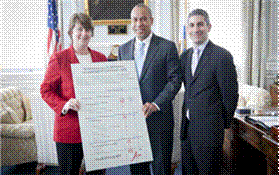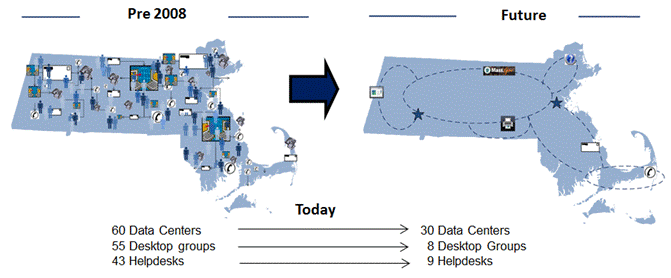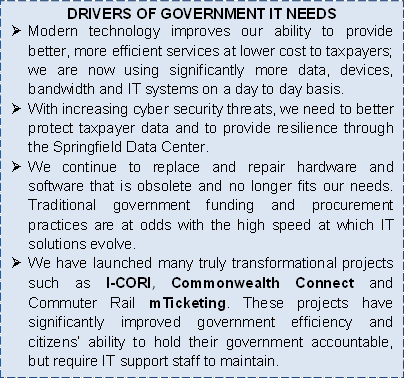
 FY 2015 Budget Recommendation:
FY 2015 Budget Recommendation:
Key Initiatives
Deval L. Patrick, Governor
Governor Patrick has managed state finance responsibly and effectively during some of the most challenging fiscal times in generations, while still working to create growth and opportunity throughout the Commonwealth. He has maintained balanced budgets by thoughtfully prioritizing among public investments and making government work more efficiently. Under his fiscal leadership, the Commonwealth has secured the highest bond ratings in its history.
Throughout his Administration, Governor Patrick has been focused on changing the way government does business and has implemented numerous reforms and savings initiatives across state government.
Developing and Managing Budgets that are Structurally Balanced – The Patrick Administration was the first to develop and publish a Long-Term Fiscal Policy Framework to ensure that budgetary decisions are informed by long-term financial forecasts and policies that support fiscal sustainability. Governor Patrick has further secured the enactment of laws that transfer volatile capital gains tax revenues in excess of statutorily designated thresholds into the Stabilization Fund instead of relying on them for ongoing budget needs. The Governor’s FY 2015 budget cuts the state’s use of Stabilization Funds (and reduces the net use of other one-time resources) to support annual spending in half from FY 2014, and the Stabilization Fund is forecasted to end FY 2015 at $1.2 B, basically level to the prior year’s balance.
Containing Health Care Cost Growth – The rising costs of health care are one of the most challenging fiscal problems today. The Patrick Administration’s groundbreaking efforts to contain health care costs have bent the health care cost curve; health care cost control legislation is expected to reduce costs in the Massachusetts private health care sector by $200 B over the next 15 years and has saved over $1.7 B since FY 2009 on state health care costs at MassHealth, Commonwealth Care and state employee health insurance programs. Through Municipal Health Reform, the Group Insurance Commission (GIC) has opened its doors to cities and towns to participate in the state health insurance program. Since the Administration proposed Municipal Health Reform in January 2011, more than 240 municipalities and regional school districts came to agreements with employees, achieving premium savings (by changes in local plans or through joining the GIC) totaling more than $230 M.
Addressing our Long-Term Liabilities – Governor Patrick secured enactment of pension reform legislation to help curb the most egregious abuses, change the system to make it more fair and equitable for taxpayers and all state workers, make the pension system more sustainable and credible over time and help restore the public’s trust in state and municipal retirement systems. Pension reform will save the state and its cities and towns $5 B over the next 30 years, and retiree health benefit reform legislation proposed by the Governor would save an additional $20 B. The Governor’s FY 2015 budget significantly increases the state’s annual contribution toward its pension liabilities, as part of a framework jointly endorsed by the Administration and the Legislature to accelerate the full funding of these costs. Working with government and labor leaders, the Administration developed a proposal pending before the Legislature to address the state’s huge, underfunded retiree health care liability, while maintaining this benefit for career public employees. This Administration has also created and is on track to deposit $180 M (since FY 2013) into a State Retiree Health Benefit Trust Fund to begin to address our unfunded retiree health benefit liability. Finally, the Patrick Administration is the first to develop and publish a Debt Affordability Policy to responsibly constrain borrowing to affordable levels and is the first to publish a Five-Year Capital Investment Plan based on this policy.
Making State Government More Results-Oriented, Data-Driven and Accountable – The Patrick Administration has made great progress in making more information on government spending, revenue and performance publicly available. Publishing online the statewide use of the $7 B in federal American Recovery and Reinvestment Act (stimulus) funds that Massachusetts received was an important step towards improving public accountability. The subsequent launch of Open Checkbook in 2011, a website that provides the public with easy and searchable access to more than 85% of state government spending and tax credit information, built on that foundation of transparency. These actions have earned Massachusetts an A- on Transparency from the U.S. Public Interest Research Group (U.S. PIRG), a 2nd in the nation rating. The Patrick Administration has also worked to improve tracking of federal grants that state government receives to ensure effective use of these funds.
Governor Patrick will release for the first time with his FY 2015 budget:
 Secretariat Performance Reports – For the first time in Massachusetts
state government history, each
of the eight Executive Branch Secretariats has published a performance report
alongside the Governor’s FY 2015 budget to update the public with data that
evidences progress toward achieving the goals each Secretariat identified in
their strategic plans, published with the FY 2014 Budget Recommendation.
Secretariat Performance Reports – For the first time in Massachusetts
state government history, each
of the eight Executive Branch Secretariats has published a performance report
alongside the Governor’s FY 2015 budget to update the public with data that
evidences progress toward achieving the goals each Secretariat identified in
their strategic plans, published with the FY 2014 Budget Recommendation. In the Governor’s FY 2015 Budget, the Patrick Administration is announcing further initiatives to improve government efficiency and effectiveness while producing cost savings.
Information Technology (IT) enables the delivery of critical services to constituents in a better, faster and more efficient manner than would otherwise be possible. Governor Patrick issued Executive Order 510 in 2009, and Executive Order 532 in 2011, to improve IT service levels and increase efficiency while reducing IT cost escalation. To date, the Commonwealth has achieved $14.4 M in savings from IT consolidation.[1]
![]()
![]()

 While
the Administration has made progress toward efficiently operating Commonwealth
IT, government and the private sector are learning lessons about how to be more
strategic and successful in selecting, procuring and overseeing the
implementation of IT projects. An emerging set of “best practices” – focused on
even more centralized oversight and accountability and more rigorous up front
evaluation of underlying business needs and project strategies – informs a next
set of IT reforms being implemented by the Patrick Administration:
While
the Administration has made progress toward efficiently operating Commonwealth
IT, government and the private sector are learning lessons about how to be more
strategic and successful in selecting, procuring and overseeing the
implementation of IT projects. An emerging set of “best practices” – focused on
even more centralized oversight and accountability and more rigorous up front
evaluation of underlying business needs and project strategies – informs a next
set of IT reforms being implemented by the Patrick Administration:
– Elevating the role of the CCIO to provide strategic oversight of IT projects and underlying state business decisions.
The Patrick Administration is similarly committed to utilizing technology to create efficiencies and to save taxpayer money. Safety net agencies spend time and resources to verify that those who apply for their services are eligible, using authorized data that is maintained by other agencies. Under the current or old model, the Department of Revenue exchanges large batches of data with agencies, including wage information, bank match information and 14-day new hire information, which is used to verify an applicant’s eligibility for various Commonwealth programs.
The Patrick Administration has introduced a new Interagency Data Services (IDS) model, which is a secure web-based service that provides targeted data verification for authorized agencies, reducing the need for large batch file exchanges of important data files. This enhanced business model will provide authorized agencies with access to targeted information necessary to validate required program business rules, thereby allowing more effective detection and prevention of fraud, waste and abuse across government programs. The state could save $20 M annually by reducing instances of fraudulently acquired services.
![]()
![]()
 Upon
taking office in 2007, the Patrick Administration inherited public
infrastructure that had suffered a generation of underinvestment. Agencies
lacked incentives to adequately fund building care and maintenance as they made
difficult choices to support public services with limited resources, often at
the expense of public assets. Through the Capital Investment Plan, the Patrick
Administration has taken steps to reverse this pattern of underinvestment and
reduce the deferred maintenance backlog. Integrated Facilities Management
(IFM) puts in place a structure to protect that investment by transferring
responsibility for building maintenance to the Division of Capital Asset
Management and Maintenance (DCAMM) to ensure that facilities are overseen and
maintained properly into the future.
Upon
taking office in 2007, the Patrick Administration inherited public
infrastructure that had suffered a generation of underinvestment. Agencies
lacked incentives to adequately fund building care and maintenance as they made
difficult choices to support public services with limited resources, often at
the expense of public assets. Through the Capital Investment Plan, the Patrick
Administration has taken steps to reverse this pattern of underinvestment and
reduce the deferred maintenance backlog. Integrated Facilities Management
(IFM) puts in place a structure to protect that investment by transferring
responsibility for building maintenance to the Division of Capital Asset
Management and Maintenance (DCAMM) to ensure that facilities are overseen and
maintained properly into the future.
Under the direction of DCAMM, IFM has been successfully instituted in several state office buildings, and in one of DCAMM’s key buildings has generated $736,000 in net savings, after investing in immediate deferred maintenance needs. Savings have been achieved through enhanced maintenance standards, improved space utilization, consolidation of utilities and service contracts, a modernized facility workforce and energy savings as a result of the Accelerated Energy Program (described above). As IFM expands to include more state buildings, further taxpayer savings will be achieved, with a long term goal of saving 10% of building operating costs.
In the FY 2015 budget, the Patrick Administration has created a sustainable budgetary framework to embed IFM in state government and devised a “rent” methodology for state buildings to set appropriate space utilization incentives and in the future reduce external lease costs by moving more agencies into state-owned space. Governor Patrick’s continued support of this program in FY 2015 will allow agencies to return their focus to their core mission of serving their populations and ensure that the Commonwealth’s assets are maintained properly into the future.
The Commonwealth is the largest employer in the state, managing about 40,000 Executive Branch employees alone. Managing such a large number of employees in a way that maximizes taxpayer benefit is critical to government success. In 2010, Governor Patrick issued Executive Order 517, directing the Human Resources Division to improve administrative efficiency and effectiveness by modernizing and standardizing human resources business processes and by leveraging technology to reduce costs. In 2012 and 2013, the Patrick Administration successfully implemented automated timesheets which has reduced by 61% the number of manual transactions completed on this human resources function. Through the Governor’s FY 2015 budget, the Administration will develop a Commonwealth Workforce Plan, highlighting the common needs and remedies needed to effectively address our aging workforce.
[1] http://www.mass.gov/bb/cap/fy2013/exec/hreport_10i.htm
Prepared by the Executive Office for Administration and Finance ·
www.mass.gov/budget/governor
For more information email: contactanf@massmail.state.ma.us (617) 727-2040